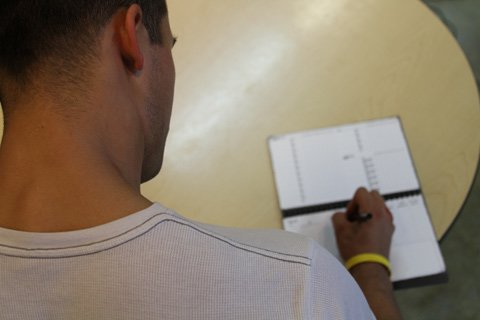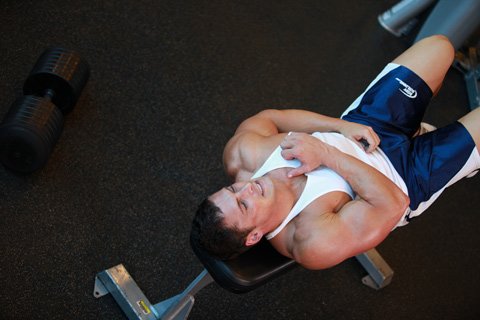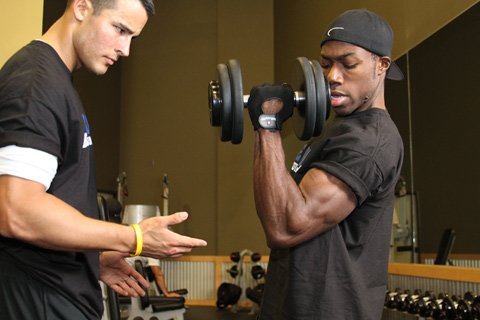Clang, clang. You rack up the weights and step back. You bite your lip. Maybe that's too much weight. Maybe it's going to hurt. Maybe you should just take a couple weight plates off the bar before you attempt this lift.
That's your resistance to pain talking. And if you give in to it, you're not going to see the results you want.
Look, I completely understand resistance to pain. You might look at my pictures and read my articles and think that I have some freaky high tolerance to pain. Not true. In fact, I dealt with asthma as a child. My fear of that re-living that squeezing, exercise-induced pain kept me from exercising for years.
But then something happened: I discovered the difference between good pain and bad pain. And once I did that, I started to enjoy the good pain, because I knew it was bringing me the results I wanted.
Let me explain...
What Is Pain?
Pain is part of your body's natural defense mechanisms. When you touch a hot stove, the pain receptor shoots a super-fast message to your brain that says "Remove your hand, pronto!" And in doing so, you save yourself from serious injury (and prevent future injury). 1
Another example: If you're running without properly warming up first, you might tear a muscle. That searing pain tells you to stop running immediately. And the continued pain for the next several days is your body's way of telling you to take a few days off so that you can rest and recover.
This is bad pain. It's a definite red-flag warning from your body.
Now let's compare this to good pain. Good pain isn't searing and long-lasting. It doesn't rip into you and command you to stop. It's not intolerable.
Instead, good pain is short-lasting. If you're out of shape and trying to run a mile, you're going to feel a little pain. If you try to lift a weight you've never lifted before—and you do it to muscle failure—you're going to feel a bit of pain. This sort of pain usually dissipates soon after you stop the exercise.
If you lift to failure, you're also going to have that familiar pain (soreness and stiffness) the next day. This is due to microscopic tears in your muscle. But you need to tear down your muscle in this way in order to build it back up. And thus this too is a good kind of pain.
Even though this good pain tells you that you're getting in shape and getting the results you want, you might still resist it. And if you resist it too much, you might just start avoiding exercise altogether (like I used to).
Fortunately, a lot of it is mind over matter. You might even start looking forward to good pain once you read the tips below...
Resisting The Pain
It's true, different people have different thresholds for pain. Some of it is due to individual differences. But scientists have also shown that gender2, cultural differences, and even the level of social support the person receives3 all affect pain tolerance. Scientists have even proven that if you expect something to be painful (and you fear that pain), you're more likely to truly experience the pain.4
Obviously, you can't change your culture, gender or other static factors to increase your pain threshold. However, there are steps you can take. For example, having a supportive partner or friend spot for you will help provide the social support that's known to decrease pain.
Another thing you can do is develop mental toughness. Fortunately, this can be learned. And once you learn it, you won't expect or fear pain as much, which will in turn actually decrease your pain. And any pain you do feel won't seem as bad, simply because you know you're feeling this pain for a good reason.
Let's go over the seven keys of mental toughness that scientists have uncovered5...
Key 1: Change Your Thinking
Stop thinking "Ouch, it hurts!" Instead, think about how that little twinge you feel is a sign that you're on track to getting awesome results.
Key 2: Improve Your Technique
Practice, practice, practice. Get a personal trainer and have him or her watch your technique. Once you get the hang of how to do an exercise, practice it in front of the mirror. As your familiarity with an exercise grows, so will your confidence, which will decrease the pain. Plus, good form helps you avoid bad pain.
Key 3: Know Your Motivation
Get clear about what you want to achieve. When you have a good, strong and emotional reason for wanting to achieve a goal, you won't let a little thing like pain stand in your way.
Key 4: Believe In Yourself
Avoid naysayers and stick to positive beliefs about your abilities. Whenever you start feeling a little down, just look in your exercise journal to see how far you've come. Doing so will propel you to keep moving forward.

 Click To Enlarge.
Click To Enlarge. Whenever You Start Feeling A Little Down, Just Look In
Your Exercise Journal To See How Far You've Come.
Key 5: Stay Focused
Forget about the people around you. Forget about being distracted by your emotional response to pain. Instead, give 100% of your mental effort to focusing on the exercise you're doing and staying positive. Just remember that through this good pain comes fantastic results.
Key 6: Handle Pressure
Things will go wrong. Sometimes you'll make mistakes. And you might want to beat yourself up for it. But when you do that, you're opening your mind to accepting negative thoughts... and in turn, you let things like pain dictate your behavior.
Don't do it. Stop fighting the pain and opening yourself to negativity. Instead, forgive yourself and move on when you make mistakes. Stay positive. And reaffirm that the pain you're feeling now is a small price to pay for the grand results you'll enjoy later.
Key 7: Mentally Prepare
As mentioned above, you don't have to fear pain (as doing so makes it more likely you'll experience it). However, you can prepare for it. Take a few minutes before each workout to mentally prepare yourself. Create a routine. It might be a simple stretching routine, special music, preparing your sports drink or reviewing your workout. Whatever works for you!
Remind yourself that you're special because not everyone can do this. Remember that the burn is a sign you're doing the right thing. And great results are on the way!
Summary
By overcoming resistance to pain we can train at the level required to see results and achieve a higher level of performance. Not only that, by becoming mentally stronger in the gym, I am able to cope better with the stresses and pressures of everyday life. My focus is more disciplined and I don't let emotional pain such as frustration or disappointments get in the way of achieving my goals!
References:
- Lynn, B (1984) "Cutaneous Nociceptors" in Holden, AV & Winlow, W. The Neurobiology of Pain. Manchester, UK: Manchester University Press. p. 106. ISBN 0-7190-0996-0
- Daniel Lowery, Roger B. Fillingim, and Rex A. Wright, D; Fillingim, RB; Wright, RA (March/April 2003). "Sex Differences and Incentive Effects on Perceptual and Cardiovascular Responses to Cold Pressor Pain". Psychosomatic Medicine 65:284-291 (2003) 65 (2): 284-91. doi:10.1097/01.PSY.0000033127.11561.78. PMID 12651996. http://www.psychosomaticmedicine.org/cgi/content/full/65/2/284.
- Jennifer L. Brown, David Sheffield, Mark R. Leary, and Michael E. Robinson (March/April 2003). "Social Support and Experimental Pain". Psychosomatic Medicine 65:276-283 (2003) 65 (2). http://www.psychosomaticmedicine.org/content/vol65/issue2/.
- Jensen J, et al "The Predictive Effect of Fear-Avoidance Beliefs on Low Back Pain Among Newly Qualified Healthcare Workers With and Without Previous Low Back Pain: A Prospective Cohort Study" BMC Musculoskeletal Disorders 2009.
- What is Mental Toughness and how to Develop It? David Yukelson, Ph.D., Coordinator of Sport Psychology Services, Morgan Academic Support Center for Student-Athletes, Penn State University




